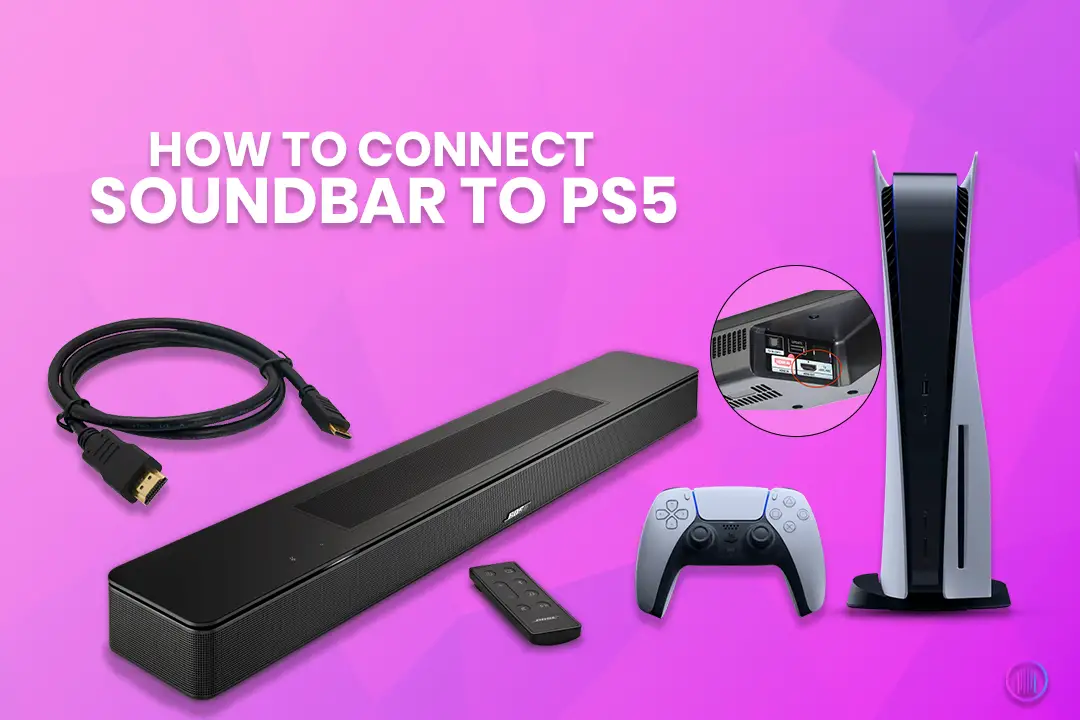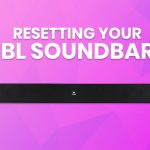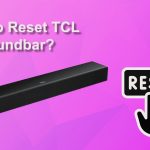Looking to boost your PS5 gaming experience with some serious audio power? I get it, the right sound can totally transform your play. That’s why hooking up a soundbar to your PS5 could be just the ticket. Not only do soundbars pack a punch with their sleek design and superior sound, but they’re also pretty straightforward to connect. So, whether you’re into the subtle sounds of stealth games or the all-out chaos of an action-packed shooter, I’ll guide you through each step to get your soundbar up and running. Ready to dive in and give your gaming sessions a major upgrade? Let’s get started.
Key Takeaways
-
The best way to connect your PS5 to a soundbar is using the HDMI eARC port. This reduces video delay and makes online gaming smoother.
-
For better sound and video quality, it’s important to use premium HDMI cables. They help you get the most out of your devices.
-
In the PS5’s sound settings, choose “AV Amplifier” and adjust the sound according to your speaker setup. This will give you the best surround sound experience.
-
To make your gaming more immersive, turn on surround sound in the PS5 settings and set up your speakers to match the action in your games.
-
If you don’t have HDMI ports, you can still connect your soundbar to the PS5 using Bluetooth or an optical cable, but be aware of possible sound delays or compatibility issues.
Things you should know before you connect Soundbar to PS5
To start off, I recommend having the prerequisites at hand to establish the connection. They are:
- PS5 console
- A compatible Soundbar (preferably the one with HDMI input and HDMI output ports)
- 2 Premium HDMI cables: Users usually get confused about the quality of the HDMI cable, and there’s been a long debate on which HDMI cable you should use. Although any HDMI cable would work to make the connections, it is highly recommended that you choose the premium one. This will ensure that you’re making the most of your device’s capabilities.
- A TV with an ARC-enabled HDMI port
Please note, a lack of HDMI ports on your TV will prevent a successful connection.
The ideal method of Connecting the Soundbar to PS5: HDMI eARC Connection
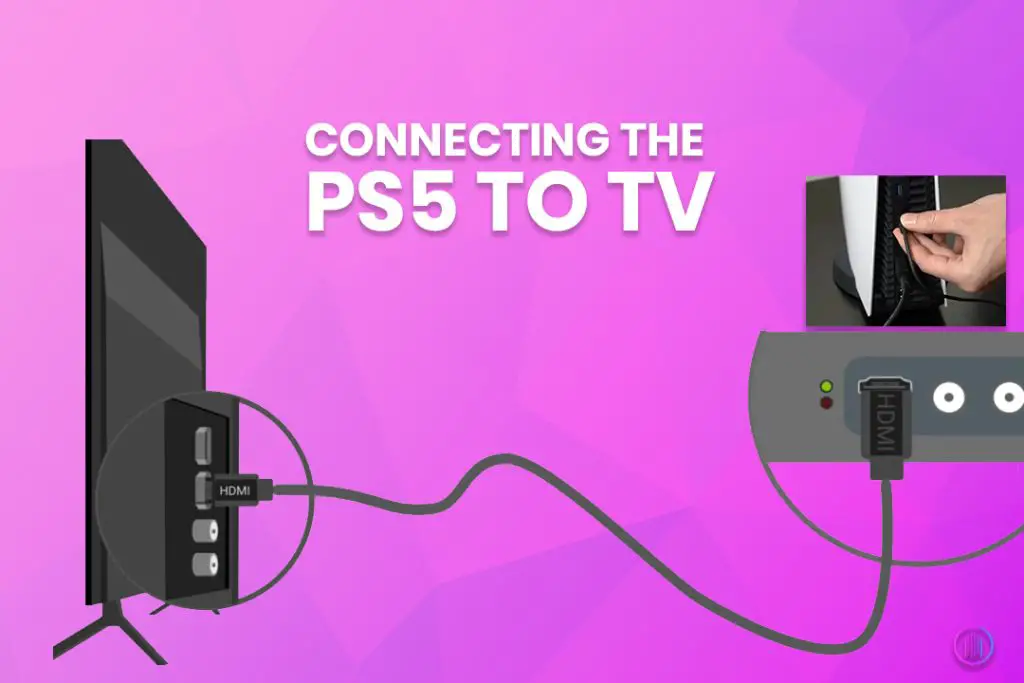
The optimal method for connecting a PS5 and a soundbar involves using an eARC HDMI port. In this method, instead of connecting the two devices together, I rather connect them to the TV.
For this connection to work, I suggest ensuring that your TV has an eARC HDMI port in addition to other HDMI ports. Also, your soundbar should have an HDMI port available. You may also resort to this method in case your soundbar doesn’t have separate HDMI input/output ports. Additionally, you’ll need 2 premium-quality HDMI cables. Follow the steps given below to make the connection.
- Connect your PS5 to your TV using the simple HDMI ports. Connect one end of the HDMI cable to your PS5 HDMI port. Don’t forget to use a premium quality cable or else you will miss out on the smooth streaming.
- Connect the other end of the same cable to your TV’s HDMI input port.
- Now take another HDMI cable and use it to connect your Soundbar directly to your TV. Connect one end of the cable to the HDMI port on the soundbar. Then connect the other end of the HDMI cable to your TV’s eARC HDMI port.
Directly connecting both the soundbar and the PS5 to the TV minimizes the risk of video latency. Furthermore, the eARC connection will result in optimal streaming without any lagging.
So, this connection is ideal for gamers who compete online, and that, of course, requires incredibly smooth streaming without compromise.
Using your soundbar’s HDMI input/output Ports
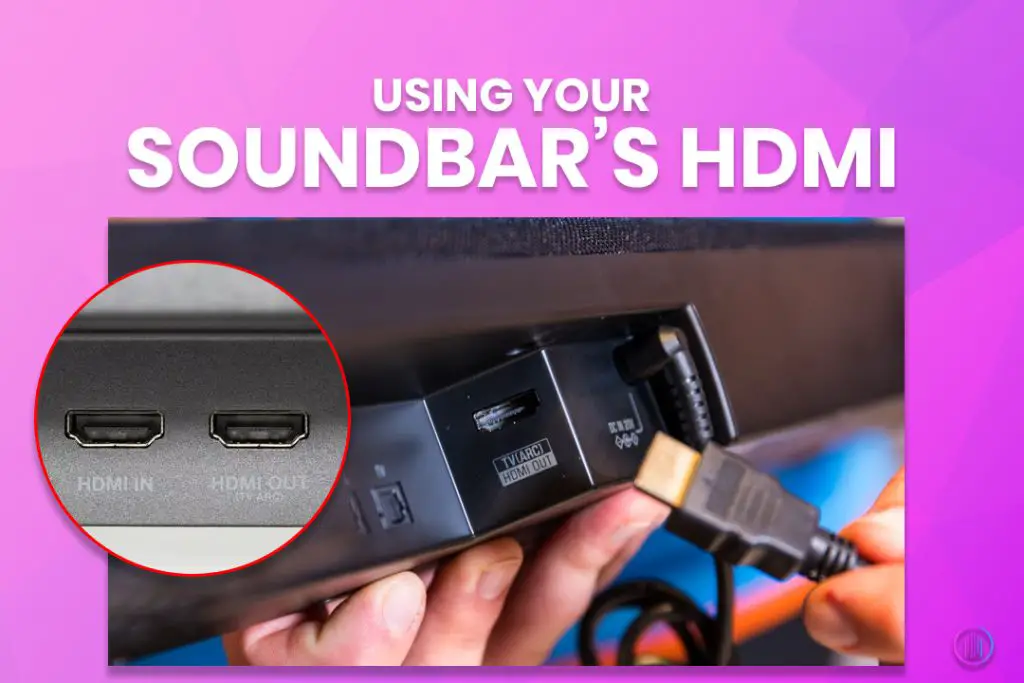
The first thing I advise you to check is whether your soundbar has the required HDMI ports. The HDMI input and HDMI output ports. If it does, you can directly connect your PS5 to the soundbar. Follow these steps to establish the connection:
- Simply connect your PS5 to the available HDMI input port on the soundbar.
- Once you’ve done that, locate the HDMI ARC port on your TV.
- Now use another HDMI cable to connect the soundbar’s HDMI ARC port (HDMI input port) to the TV’s HDMI ARC port.
And there you have it! You’re all set to immerse yourself in a riveting gaming experience.
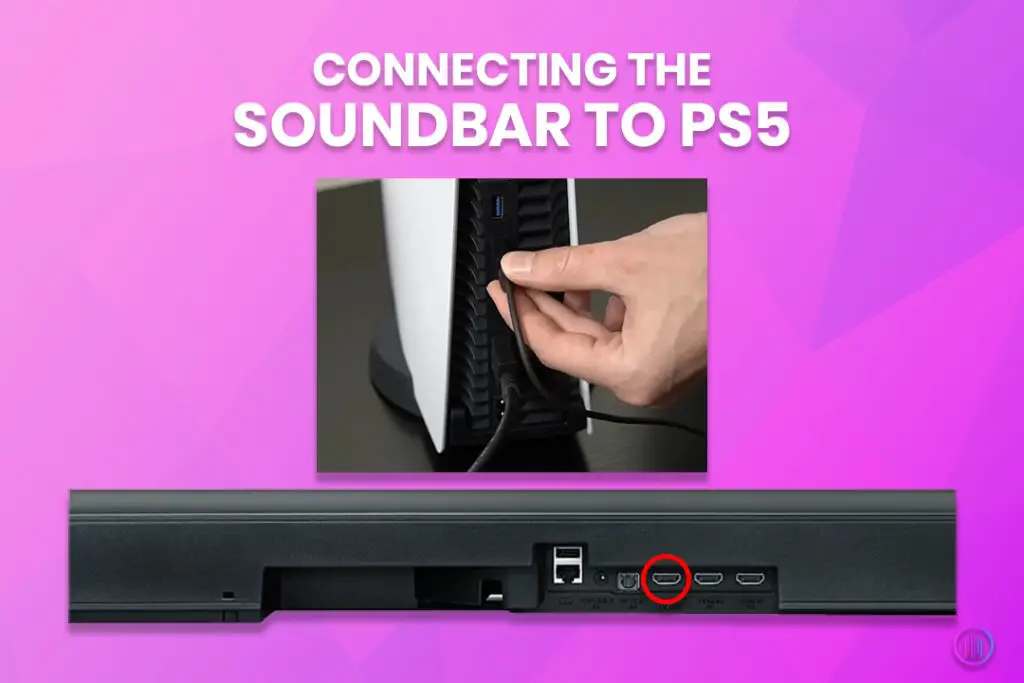
In this method, the passthrough capability of your soundbar comes into play. Your soundbar passes the video signals from your PS5 to the TV. Moreover, this connection provides the best experience from the audio tracks, creating immersive sound output. This eradicates the risk of downgrading the audio signals that pass through the TV.
But wait! This type of connection can also have some streaming issues.
In case you have the latest TV model that supports 4K 120Hz, you won’t be able to establish this connection. The reason behind this is the limited compatibility of the soundbars.
Unfortunately, almost no soundbar has the ability to run a 4K 120Hz passthrough. It is imperative to have compatible devices. Otherwise, the best option is to skip to other methods of connection.
Lastly, it’s worth noting that most TV models on the market have compatibility with the features offered by available soundbars. So this method of connection should work most of the time.
Adjust the Sound Settings for Smooth Streaming
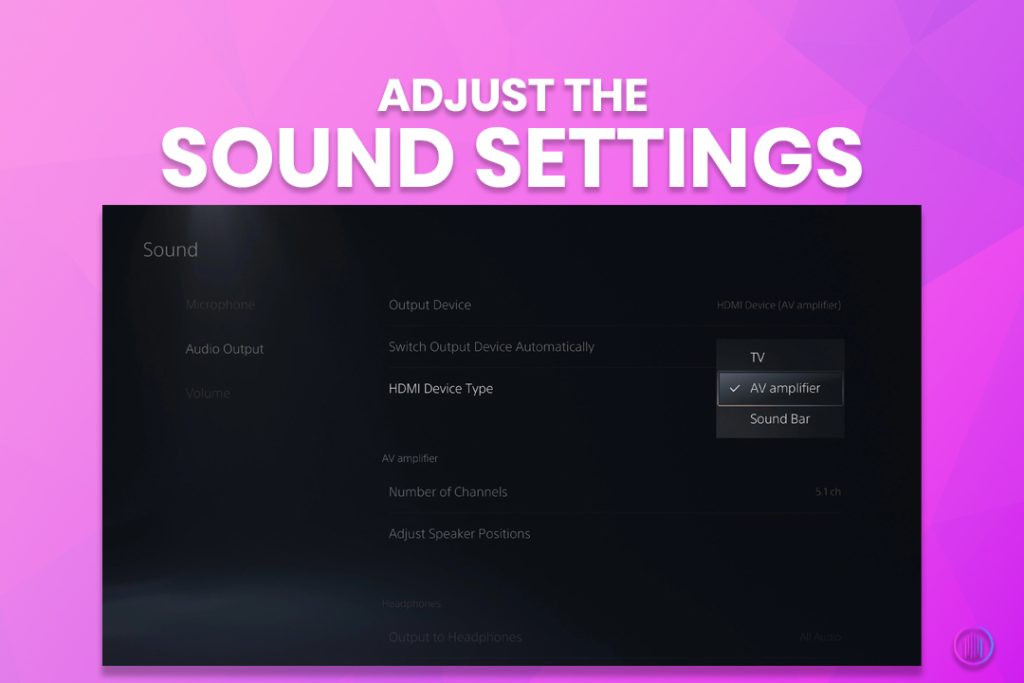
There are possibilities that despite all my tips for smooth connections, you might still get glitches in streaming. At times the users do not hear the sound output from the soundbar or the video output on the TV. This is exactly when you should navigate through your devices’ sound settings. Different manufacturers offer unique device settings that must be optimized to work in harmony for the desired output.
- Firstly, you should go to your PS5’s sound Settings.
- From there, select Audio Output > HDMI Device Type.
- Select the “AV Amplifier” from the list.
This will ensure a better surround sound than if you select the “soundbar” option.
The ‘AV Amplifier’ setting will prompt you to select the number of speakers in your setup. This way, you may adjust the angle of the audio hardware setup you have.
Last but not least, in case your PS5 is directly connected to the TV, you should return to the Audio Output menu. Now set the Audio Format to DTS or Dolby for optimal results. Otherwise, in case your PC5 is connected to the soundbar, set the Audio Format to “Linear PCM.”
Enable Surround Sound and get the most out of your Soundbar
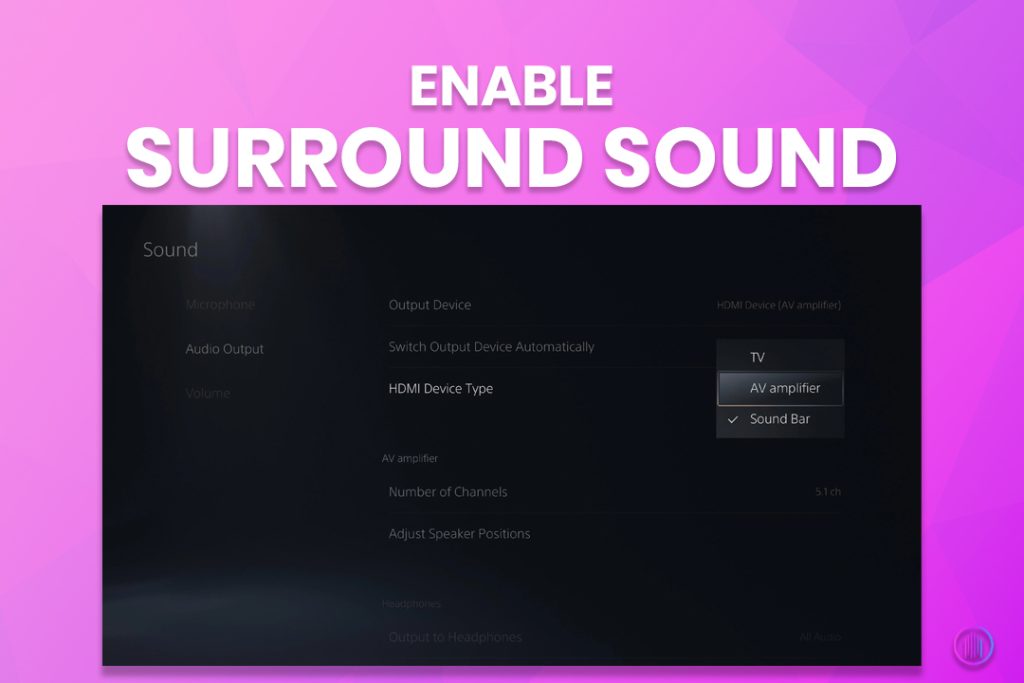
Smooth game streaming is incomplete without immersive audio. Therefore, it is equally important to optimize your devices’ settings to enable surround sound. I believe that enabling surround sound will make your gaming experience worthwhile.Follow the steps given below to enable surround sound.
- Go to your PS5’s sound settings > Audio output > HDMI Device Type > Soundbar.
- From there, adjust your speakers’ position to match the action in your game.
- Then go to “Audio Format” and change that to “Dolby.”
This should enable surround sound on your gaming rig for an immersive experience.
Certainly! Here’s how you could expand your article to include information on Bluetooth and optical cable connections, as well as a discussion on input lag. I’ll write it in the first-person perspective and include real-world testing scenarios for a more engaging and unique read.
Alternative Connection Method: Bluetooth
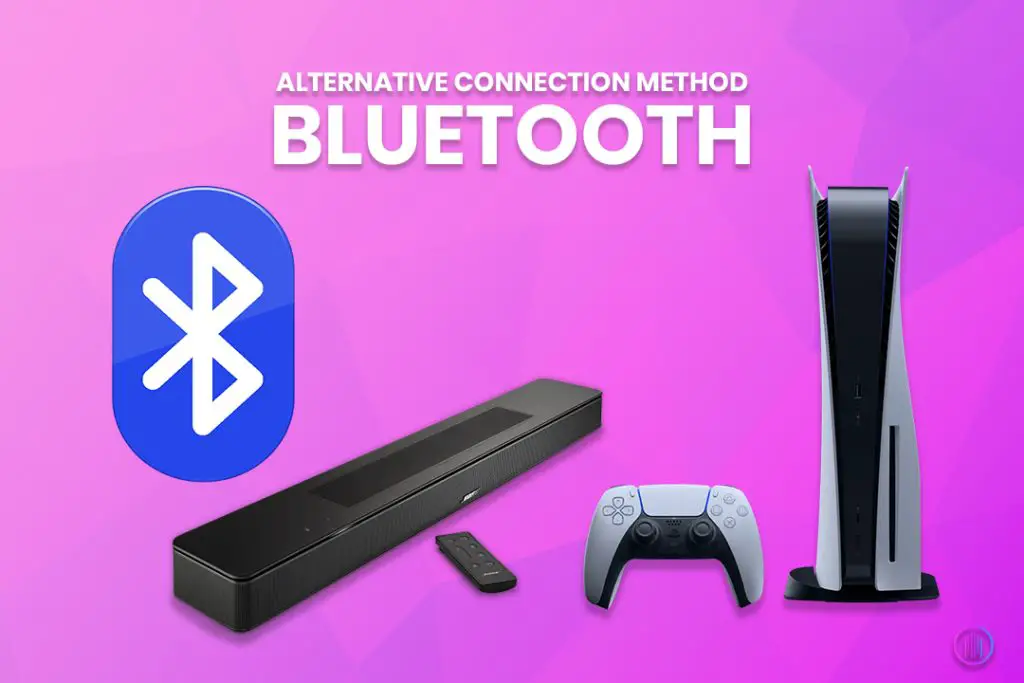
Bluetooth Connection: The Wireless Way
You might be wondering, “Can I go wireless?” The answer is yes but with some caveats. I tried connecting my PS5 to my soundbar via Bluetooth, and here’s what I found:
- PS5 Limitations: Unfortunately, the PS5 doesn’t natively support Bluetooth audio output to soundbars. However, you can work around this by connecting your soundbar to your TV via Bluetooth and then connecting your PS5 to the TV via HDMI.
- Latency: One thing I noticed during my testing was a slight audio delay, especially during fast-paced action scenes in games. This is a common issue with Bluetooth connections, so keep that in mind if you’re a stickler for audio-visual sync.
- Audio Quality: The audio was crisp and perfectly in sync with the action on screen. However, do note that optical cables don’t support the highest-quality audio formats like Dolby Atmos.
The Elephant in the Room: Input Lag
Now, let’s talk about something that’s often overlooked but incredibly important for gamers: input lag. During my testing, I noticed some differences in input lag based on the connection method:
- HDMI: When I connected my PS5 directly to the soundbar via HDMI, I experienced minimal input lag. The gaming experience was smooth, and I could react in real time during fast-paced games.
- Bluetooth: As mentioned earlier, the Bluetooth connection did introduce some audio lag. While it wasn’t a deal-breaker for casual gaming, it could be a concern for competitive gamers who rely on split-second timing.
Hands-On Gaming Experiences
To give you a better idea of how these connection methods impact gaming, let’s consider some real-world scenarios:

- Playing ‘Call of Duty’: When I used the Bluetooth connection, I noticed a slight delay between pulling the trigger and hearing the gunshot. It was a fraction of a second but enough to throw off my game.
- Exploring in ‘Assassin’s Creed Valhalla’: When connected via HDMI, the ambient sounds of the world were incredibly immersive. I could hear footsteps behind me and react in real time, which wasn’t the case with the other connection methods.
Conclusion
I firmly believe that pairing a PS5 with a soundbar is undoubtedly ideal, provided all the devices are compatible. This allows you to have an immersive gaming experience like never before. However, it’s crucial to properly connect the devices to achieve the desired results.
The devices must have HDMI ports to establish the connection, though the availability of ARC HDMI may alter the order of connections.
It’s always recommended to consult the user manual of your devices for detailed instructions on the availability of ports and recommended connections before purchase.
I invite you to share your experiences, thoughts, or any additional tips you might have in the comments section below. I love hearing from my readers!
FAQs
No, you don’t necessarily have to connect your PS5 through the soundbar to get the best audio quality. If your TV supports HDMI 2.1 and eARC, you can connect your PS5 directly to the TV. The sound will be transferred from the TV to the soundbar in high quality, such as Dolby Atmos, via the eARC connection.
If your soundbar doesn’t support 4K 120Hz passthrough, you can still enjoy high-quality audio by connecting your PS5 directly to a TV that supports HDMI 2.1 and eARC. This way, you can enjoy 4K 120Hz video on your TV while still getting high-quality audio through your soundbar.
Audio delay can be a common issue depending on your setup. If you’re experiencing audio delay, try switching to PCM audio format. Some users have reported that PCM eliminates the delay. However, if you’re using eARC, make sure to enable “pass-through” on your TV’s audio settings, as this has been reported to fix audio delay issues for some users.
The general consensus is to select “AV Amplifier” for a more immersive audio experience, especially if your soundbar has more than 2 or 3 channels. This allows you to customize the number of speakers in your setup and may provide a better surround sound experience.
This is a common issue where manufacturers claim HDMI 2.1 capabilities, but the ports are actually HDMI 2.0. In such cases, you may not be able to take full advantage of features like 4K at 120Hz. However, you can still connect your PS5 to the TV and your soundbar to the TV’s eARC port for the best possible audio and video quality under these limitations.
When you connect your PS5 directly to the soundbar, the PS5 detects that it’s connected to an audio device and passes through audio directly, which might result in louder audio. When connected to the TV, you may need to adjust settings like “Passthrough” to ensure the correct audio is being processed by the TV and then sent to the soundbar.
The choice between LPCM, Dolby, and DTS can depend on your personal preference and setup. Some users report that Dolby or DTS can introduce audio lag, while LPCM provides a raw, high bit rate, lossless audio signal. If your setup does not introduce lag with Dolby or DTS, you can choose based on which provides better sound quality to your ears.

I’m Shaun Conroy, an audiophile & founder of HiFi Audios. Holding a Bachelor’s in Sound Engineering, I bring deep expertise in audio devices and offer insights & recommendations to fellow enthusiasts.

